How to grow potatoes from seeds. Cultivation of potatoes from seeds is a guarantee of obtaining high-quality planting material.
Traditionally, farmers and gardeners grow different vegetables with seeds: cucumbers, tomatoes, peppers, and more. But why are gardeners not in a hurry to plant in this simple and straightforward way almost the most consumed crop - potatoes? The thing is that with respect to this plant the method with seeds turns out to be troublesome and energy-intensive. However, some gardeners still turn to him when the next harvest of potatoes becomes more and more modest, which affects not only the quality, but also the number of tubers.
Most often, gardeners select the most healthy tubers, counting on the subsequent harvest. Even generous fertilization of the soil does not guarantee that in the fall you will dig up a much larger number of potatoes than you originally used. This is due to the fact that over time, the tubers degenerate, which means that they become a kind of accumulators of various diseases, including bacterial and fungal. This affects not only the quantity of the crop, but also its taste. If we consider that we grow potatoes for eating, its taste in many ways becomes the determining factor for farmers.
Planting tubers has its disadvantages
There are two main ways to try to restore the yield: either periodically purchase expensive tubers for planting, or grow roots from seeds. As practice shows, the second method is not only more interesting from an economic point of view, but also more reliable, because some sellers under the guise of elite varieties may sell potatoes, the quality of which will leave much to be desired. If you are not a professional in this field, then it will be almost impossible to distinguish one from the other.
Pros of growing potatoes from seeds
Growing potatoes from seed is an attractive option because:
- seeds cost significantly less than tubers;
- seeds do not take up much space, they can be stored in a tiny bag, whereas tubers require at least a cellar;
- root crops grown from seeds are characterized by resistance to late blight and various diseases;
- potato seed yield is higher than with standard planting.
Seed propagation
Seed propagation is also not a problem-free option, since each method has its own drawbacks. In this case, we can talk about excessive "sensitivity" of seedlings, since they will react to the slightest deviations from the ideal conditions for them. For example, if you plant potatoes in the shade, the lack of light will lead to excessive stretching of the seedlings.
Plus, if you multiply the roots with seeds, then root system plants will form a little slower. In order to speed up the result, it will be necessary to tackle the ground closely - constantly loosening or growing potatoes on sawdust until the seedling height reaches 3 centimeters.
Another drawback is the weakness of seedlings, and only systematic use of various biologics, such as planriz or black yeast, will help strengthen them. You also need to be prepared for the fact that even with proper care, the seedlings of the root crop will turn out to be quite fragile, which means that during transplantation, the probability of damaging them increases and thus losing part of the crop.
Stage 1: seed preparation
There are two main ways to get potato seeds: purchase them from specialists or prepare them yourself. For the second option, it is necessary to wait for the moment when small berries appear on the planted potato bushes - this usually happens in summer. They are collected in bags of gauze and suspended for some time in a bright and warm room.
When the berries become softer and get a light shade, they need to be crushed in any container and get the seeds. They are washed, dried and packaged in bags. When harvesting seeds it is worth considering that their germination in the first year will not be too impressive, so it is better not to save.
Traditionally, gardeners sow seeds for seedlings at the end of winter or at the very beginning of spring. First you need to wrap the seeds with a damp cloth, put them in a plastic container and cover with a lid. It is very important that the fabric is always wet, but the cover from the container must be periodically removed for ventilation. After 5 days, the first shoots should appear. At the same time, you can put the seeds on the previously prepared soil (moist and compacted), and then sprinkle with sand about 1 cm.
Stage 2: proceed to landing
When we talk about the multiplication of potatoes with seeds, we mean the seedling method of cultivation. Consequently, the farmer will need not only the soil and seeds, but also a suitable container, as well as a place on the window. In addition, it will take a lot of free time.
Preparing a container for seedlings
In the process of growing a root, it must necessarily dive. For the first time, small yogurt cups will do, and then you need to find a half liter container.
As mentioned above, for seedlings of potatoes it is necessary to prepare a very loose and fertile soil. The ideal combination is the combination of 4 parts of peat and trichodermin (5 g of a biological product is used for 5 kg of soil). Some gardeners, as an additional “support”, a few days before sowing, trim the soil with Fitosporin.
Due to certain difficulties with the root system (slow development), it is recommended at first to grow seedlings in sawdust moistened with water - this will accelerate the process of root growth.
The next step should be spraying the seedlings. To prevent the jet from being too powerful and not damaging nascent sprouts, you need to use a spray gun. Then the seeds are covered with foil and sent to the windowsill in the sun. If possible, seedlings can be further illuminated using fluorescent lights. Until the first shoots appear, the soil should be moist, but not over-humidified, because from this the roots can "suffocate".
Spiked seedlings
After 25 days after sowing, seedlings can already be dived into pots, while lowering the seedlings to the depth of the cotyledon leaves. Already at the end of April, the container with future potatoes can be moved from the window sill to the balcony.
Stage 3: landing in the ground
When the time comes to plant young seedlings of the root, the greenhouse or greenhouse would be an ideal option, since open ground can be a great stress for weaker tubers. However, if you do not have such an opportunity, then you can do otherwise. By the end of spring, as early as May, when the ground warms up well, start sowing seedlings. This is best done either in the evening or on an overcast day when there are no scorching rays of the sun.
Video - How to make holes
Before planting the plants, you must first prepare the wells - fill them with ash and humus, and then pour. Ideally, if the distance between the pits is about 40 cm from each other. Only with such a scheme is there a chance good harvest with large tubers.
As for the holes themselves, they must be long so that the stem of the seedlings fits horizontally. Ground potatoes sprinkled in such a way that only the tops were visible on the surface. A very important stage in the cultivation of potatoes - mulching - this is done either with straw or rotten leaves. After this, it is necessary to make a frame over the plant with the help of arcs and cover it with a spunbond or film.
Given that potato seedlings are extremely capricious, the material can only be removed in the first month of summer, when it finally becomes warm. After that, you can take care of potatoes in the standard way: spud, water.
Top dressing potatoes
Since the potatoes absolutely can not tolerate drought, you need to be very careful when watering, especially if the summer is extremely dry and hot. If we ignore this requirement and leave the plant without watering in a drought, then subsequent sediments will lead to the fact that the tubers will turn out sick and inferior. Most of all the plant needs water before flowering - during this period up to 3 liters of water are needed per bush.
Potato pests
Do not forget about the eternal problem of potatoes: pests. The most dangerous and famous of them are Colorado beetles, as well as wireworms. There are several of the most common and effective ways to deal with them: sprinkling seedlings onion peel, shedding plant ash wood, additive in the wells of calendula. It is also easy to cope with the wireworm, you can plant peas or mustard in the ground before planting potatoes - they are often used as sideroitic cultures.
Video - How to grow potatoes from seed
Planting potatoes "in the old fashioned way" is not too productive. Well, if planting a bucket of potatoes can get two. But, after all, a potato is a highly productive plant, its harvest should be at least 5 buckets from one (and a record 10 to 12 buckets at all). If you are not satisfied with the meager yields of potatoes, there are several ways to increase yields.
You can experiment with unusual (intensive) growing methods. There are many opinions and ways to grow potatoes in order to get a decent harvest. If you are thinking, in a barrel, under a black film, in straw, in crests - it is easy to find detailed instructions and descriptions of these methods.
But, nevertheless, you need to start with planting material. Because of the insufficient harvest, most often, the diseases he has accumulated are to blame. Our ordinary potatoes multiply vegetatively for decades, the variety is aging, its qualities are reduced, and diseases accumulate. So, to get great harvestIt is worth considering how to grow potatoes from seed. The best result can be obtained by growing your own planting material derived from seeds using intensive technologies (here it is not far from records). Of course, it is easier to purchase elite tubers than toil with seeds. But, in fact, plants grown from seeds are much better adapted to your specific conditions. In addition, when buying seeds, you are not exactly deceived with the variety (which often happens with the purchase of varietal tubers).
Consider from seed
Potato seeds are sown at the end of April in a box with a light fertile soil, after having watered it well. Potato seeds are small, so they need only a little to cover the ground or small sawdust (not coniferous). Cover the box with a film and put in a warm place. Water very carefully, it is better through a spray or other spray, often a little, in no case fill.
Seedlings are susceptible to "black leg" - a dangerous fungal disease. To combat it use biological products (for example, black yeast, planriz). Before you grow potatoes from seed, it is advisable to stock up on these drugs. In the soil it would be good to add the drug Trichodermin or buy ready-made soil with it.
It is possible to use small sawdust instead of soil, gardeners note that seedlings on sawdust develop a large root system. In this case, the plants need to be fed with a solution with trace elements. Good results are obtained by adding wood ash to sawdust and disinfecting it before planting with a pink solution of potassium permanganate. Replant them upon reaching a height of 3 cm.
After the appearance of two true leaves, seedlings are transplanted into separate pots or, at the age of 40 days, seedlings are planted on the beds. You can plant the plants in the greenhouse immediately in the greenhouse or (if you live in the southern climate) in the open ground. Planted plants still need careful care, it is recommended to install arcs over them and cover them with lutrasil, shade from direct sunlight and water until the seedlings take root. At the end of the first year, these plants will produce seed minitubbles - this is a super-super-elite. Of them on next year it will turn out superelite, and a year later - elite potatoes. From one plant you can get about 150 miniclub, and the next year from one such nodule will come from 1kg or more. seedlings a little harder seedlings of tomatoes.
Before you grow potatoes from seed, you need to pick the right varieties for you. For the cultivation of seeds can be recommended two early and very high-yielding varieties - Assol and Empress. Another good early varieties: Ilona, Triumph, Farmer. Good mid-season variety Krasa and Lada f1 early hybrid, with tubers of different colors.
Today, most vegetable crops it is planted on plots with seeds, but potatoes are usually grown with tubers. This method is certainly simple and convenient, but it is costly, and each time gardeners pay attention that the harvest volume is gradually decreasing. Seed potatoes have a number of special advantages and require a slightly different approach to cultivation, which will be discussed in this article.
Potato propagation is carried out in several ways: by dividing the tubers, by seed, rooting the tops and planting sprouts. More important is the multiplication of potatoes by the last two methods.
Seed potatoes are mainly the result of breeding, which allowed scientists to improve some characteristics of the vegetable. Thanks to the selection, it was possible to improve the resistance of the root crop to variable weather conditions, yield, resistance to various diseases, fungi.
Unlike potato planting varieties, the cost of the plant seeds themselves is significantly lower. Since in tuber cultivation a certain part of the crop needs to be left for planting next year, this already has a definite effect on the profitability of this method.
Of course, the traditional method is very simple, but do not forget that for the whole winter period, certain conditions will be required for storing root crops. Planting material should not be affected by moisture, rodents or insects, fungal formations. You will also need to periodically sort out potatoes, regardless of its variety, since the tubers are constantly germinating, pulling out the necessary trace elements from the fruit.
Seed potatoes can save not only money, but it is also much easier to store. Packages protect the seeds from moisture, ingress of harmful microorganisms, allowing them to maintain their normal condition at the time of planting. Potato seeds are designed for a longer shelf life and take up less space (no special conditions are required, for example, a cellar or a cellar).
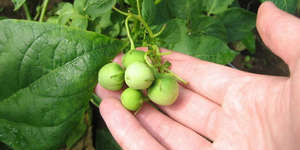
From the very beginning of planting, seed potatoes have no diseases, since selection has contributed to an increase in resistance to late blight and other adverse factors.
It should also be noted that the yield for growing vegetables by this method increases significantly. After each season you will have the opportunity to leave the most suitable tubers for planting. Since the bushes may differ from each other in the size of tubers and tops, resistance to diseases, then you will be able to give preference to the best specimens for planting next year. You will also need to take into account the characteristics of certain varieties, as they may differ significantly.
Step by Step Growing Instructions
Seed potatoes require a special approach when growing. Before planting, you will need to get seedlings, which in the future gardener will already be placed in the soil. This can be done at home, without going to the site.
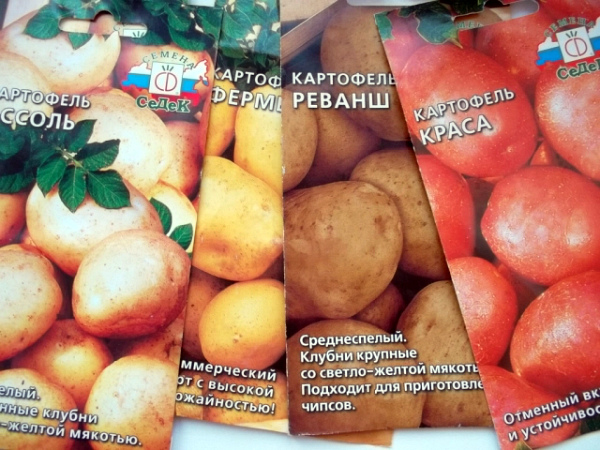
First you need to choose suitable grade potato
Among early varieties You can find the following names: Ilona, Empress, Triumph, Velina, Farmer, Ausonia and Velina. The most fruitful among them is the Farmer. No picking is required for this variety (removal of a part of the root crop to stimulate the branching of its horse system). By the mid-ripening types of varieties include: Virgo, Revenge, Ballad, Krasa.
After the gardener has determined the variety of potatoes that he will grow on his plot, you need to start preparing the seedlings.
If summer residents have the opportunity to collect seeds on their own, this should be done in summer, when berries appear on potato bushes. The berries have a greenish-white color. Thus, planting material can be collected from the previous harvest, and continue at home, preparing it for the next season. The berries are placed in gauze knit, and then hung out for ripening in a warm dry room. When the berries become soft and become lighter in color, they will need to be carefully crushed and poured into a vessel. Then they will need to be thoroughly rinsed and re-dried. It should be remembered that such planting material does not possess special germination, therefore a large amount of it will be required.
![]()
After the berries ripen, it is advisable to use the seeds for two years, since at a later time they may not be taken.
Potato seeds germinate slowly enough, so the procedure will need to be carried out in advance. The most important thing is to get the first shoots, and in the future special care for them is not required.
The first step is to soak the seeds in water. It will be enough for two days. You can also spend a special hardening of seeds. To do this, the container with them will need to be moved periodically for 10 days - put it in the room during the day, and put it in the fridge at night (but not at minus temperature).
Germination should be carried out at an average temperature of 40 degrees Celsius. To do this, you can make a small greenhouse to maintain a stable air temperature. The best time for this will be the end of March or the beginning of April.
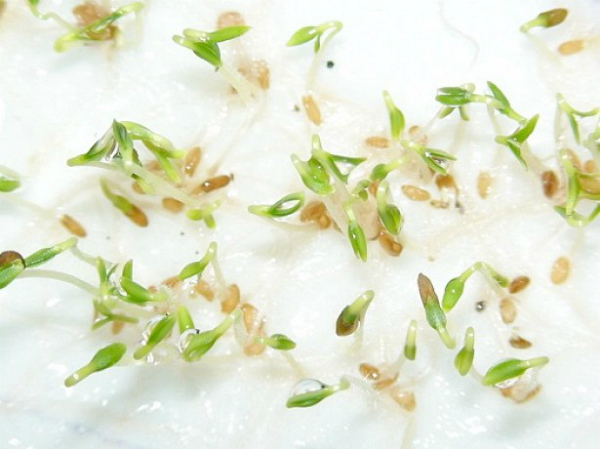
After the seeds have been picked up, you should wait a while and then start planting in the ground. It will be necessary to plant material in a special soil. To do this, mix one part of the black soil and four parts of the ground peat. Vegetable seeds will need to be arranged in rows at intervals of 10 centimeters between them, and 5 centimeters between each other in each row. Then from above you can sprinkle the seedlings with purified sand (no more than half a finger) and lightly tamp.
The first stage has its own difficulty - a weak and vulnerable root system.
The next step will need to wrap each box with seedlings tightly with a film or cover it with glass, placing it in a warm place. If everything is done correctly, then in 10–12 days the first shoots will appear. When the leaves appear, you can swoop down the plant in special peat pots, which are in stores. This procedure should be performed with extreme caution, since the first shoots are very gentle and capricious. The soil should be wet, so as it dries it will need to be watered, and when the root system becomes stronger and more developed, you can add fertilizer from ammonium nitrate to the ground.
In the future, before planting potato shoots in the open ground, it will be necessary to maintain their stable growth and not to allow abrupt changes in the environment. When the right time comes, the plants will be planted in the ground at the site.
Video "How to grow potatoes from seed"
In this video, the expert answers the relevant questions: why grow potatoes from seeds, how to sow, how to grow potato seedlings, etc.
Landing in the ground
Seed potatoes are planted after the completion of frosts, depending on the variety of the plant itself. Optimal time for this will be May. Prepare the soil before planting. Since the root system of potatoes in this case is rather slowly formed, for this, a loose soft soil is necessary.
First of all, you need to make holes. Each hole should be about 10 centimeters deep. 400–500 grams of humus is applied to it, then half a liter of water is poured. A seedling is placed in the ground so that a stalk with leaves is left above it.
If in the near future, according to forecasts, the weather may deteriorate, then you can cover the whole garden bed with seedlings with a film. With dry weather and hot sun, you need to water the potatoes about once every two days. Also, gardeners can be guided by how dry the earth is.
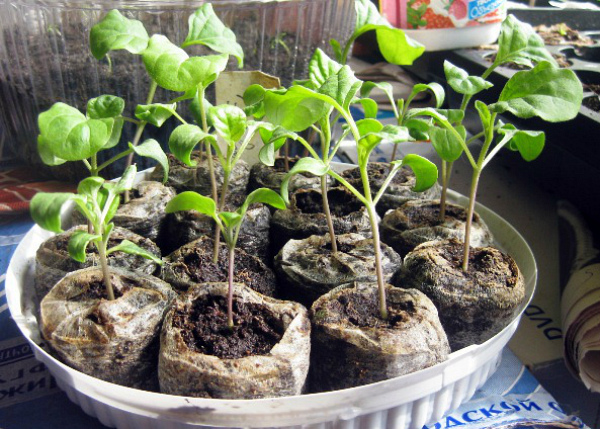
During the cultivation of seedlings in the open ground, it is necessary to spud every shrub on the beds in time, weed the weeds, loosen the ground so that oxygen and water get better into it. Based on the varieties of seeds grown, harvesting is carried out in a certain period of time. On average, the ripening of the vegetable takes 3 months. It is enough for the entire time in time to produce watering, to make fertilizers to improve the properties of the soil.
If you want to use potatoes for future planting from the current crop, it is better to collect the best tubers for this. This will allow the next season to grow vegetables without diseases, which will be similar to the collected fruits from last year. Subsequent multiplication of potatoes can be carried out using tubers.
Care
In the process of growing seed potatoes usually requires careful care of the plants. In order to get good planting material next year, it is necessary to provide favorable conditions for the growth of the vegetable.
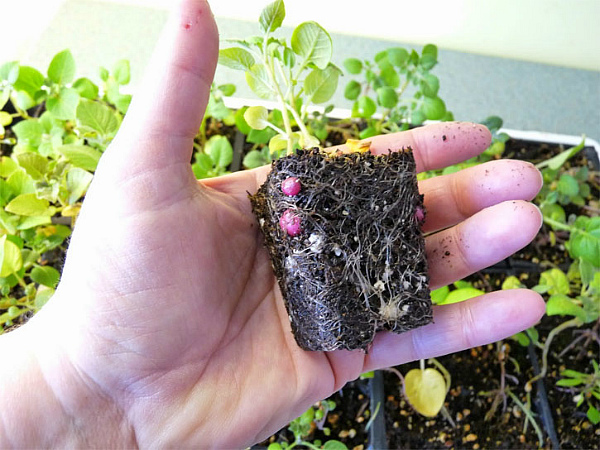
After planting the plant in open ground, you need to pay attention to the territorial weather conditions.
If the seedlings are placed in the ground too early, then sudden frosts can not only reduce the seasonal yield, but also subject the crop to diseases, provoke changes.
It is necessary to water the bushes in a timely manner so that the root system does not experience a lack of moisture. During seasonal rains, you can not water for some time, based on the amount of precipitation. If the cultivation of a vegetable takes place in greenhouse conditions, then moisture in a natural way can not get into the ground. Therefore, you need to do more watering, but little by little.
When the bushes grow, you can earthing, so that they do not go under the weight of green mass on the ground. Hilling can be done every 3-4 weeks.
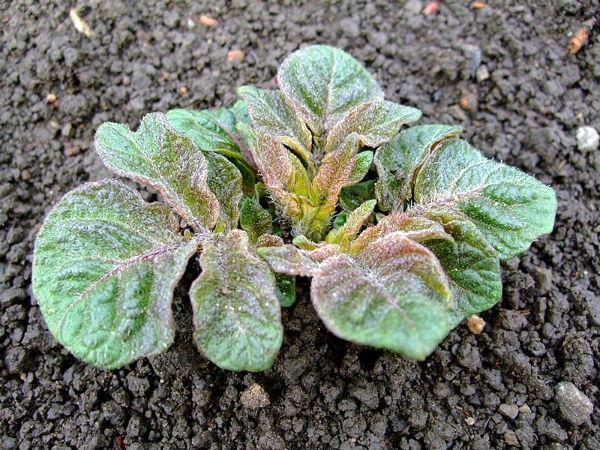
After flowering Colorado beetles often appear, which begin to devour foliage. As a result, the plant begins to hurt. This will require the use of special means of dealing with them. You can apply chemical spraying, attract birds and insects to the site that feed on Colorado beetles. At home, gardeners can themselves prepare means against pests. Among the frequently used means - a soap solution with the addition of ammonia or wood ash.
If you notice that in some places on the shrub appear uncharacteristic spots, yellowness, then they need to break off. This may indicate a disease. It is very important to determine the infection that affects the plant and spray the plants with a special chemical to get rid of it.
Special attention when growing potatoes requires feeding. Fertilizers must be applied to the soil before planting, preparing the ground, but also during the maturation of the crop, special additives may be added under the shrub. When they get water, the liquid will take nutrients into the soil, and then be absorbed by the root system.
Video "Potato seedlings: picking and transplanting"
See how picking potato seedlings sprouted from seeds looks like, as well as transplanting them into disposable cups.
Potatoes are an integral part of the human diet, because it is he who stands along with bread and water. Many do not know in what conditions are grown, as living in large cities, they are used to all the fruits and vegetables "grow" on the supermarket shelves. But those who all their lives, from early spring to late autumn, spend time in the country or household plot private house, know the technology of growing many vegetables. We offer you to find out how to grow potatoes from seed at home.
Features planting potatoes from seed
Tomatoes, cucumbers or peppers are most often grown from seeds, but not all, even the most knowledgeable gardeners know how to grow potatoes from seeds, since it’s customary to breed them using the club method.
Photos of potato tubers
Statistics show that by planting a bucket of potatoes, you can collect as much, and in rare cases, even less. It does not depend on irrigation, the level of fertilizer of the soil, but rather on the quality of seed potatoes.
Recently, the crop has been attacked by pests, so it has to be treated for all sorts of diseases and rodents. A few years ago, potato tops suffered only from the Colorado potato beetle, but today everything has deteriorated a lot. Fungi, bacteria and rodents attack the culture, which reduces its yield.
To restore the yield of potatoes there are two ways:
- buy high quality tubers;
- grow from seed at home.
Reinsure yourself against a fake, sold as high-quality tubers, you can easily, if you do yourself the cultivation of potatoes from seeds at home. Remember that the "elite" purchased tubers can not be verified.
The advantages of growing potatoes from seed:
- price;
- space saving;
- disease resistance of tubers;
- high yield.
The technology of growing potatoes from seeds
By planting seeds, you can grow quite extraordinary tubers. This allows you to see the different color, yield and size of the fruit. Provide a seedling of sufficient light to the potato seedlings, as in the dark the stalk stretches heavily. When growing seedlings of potatoes from seed, use certain drugs to avoid diseases.
Watch the video: How to grow elite potatoes from seed
Instructions breeders on growing potatoes from seed
Potato seeds can be purchased in specialized stores or procure their own. How to do it? When the potato begins to ripen, balls appear on the leaves, in which there are seeds. They are ripped off and dried, and they must change color. Remove seeds from balls, wash them and thoroughly dry naturally. Plant them worth the first or second year after collection. It is important to note that their germination is not 100%, so they will have to be planted with a certain margin. Before planting, seeds are soaked for 48 hours in water.
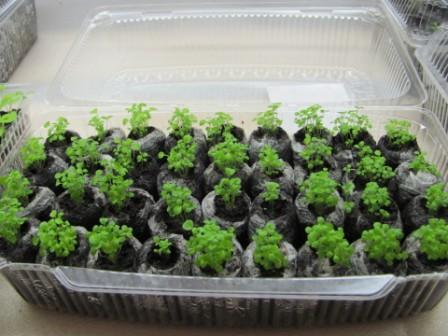
Photos of potato seedlings when grown without hilling and weeding
Potato seedlings are grown in the greenhouse, as it does not tolerate fluctuations in temperature, which contributes to frequent diseases. You can sow at the end of the first month of spring or a little later.
So that the soil is completely favorable for potato seeds, it is made in the following proportions: 1 part sawdust, 1 part of the ground and 3-4 parts of peat. Plus, fertilize the land. When growing potatoes from seeds wisely, you can avoid weeding and hilling.
In specialized stores you can buy special cells for growing seedlings, or you can put them in boxes, in rows. The distance between the seeds is five centimeters, and between the rows - ten. Planting depth of seeds is no more than 1 cm.
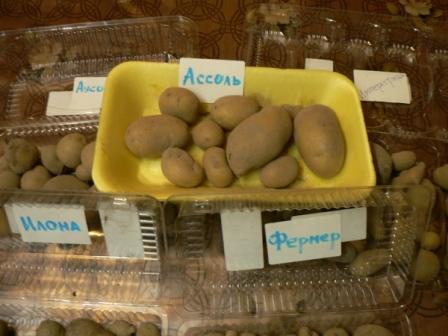
In a warm place, the seeds of potatoes sprout after ten days. If the seedlings reached the development of already two or three leaves, it needs more space for full growth. So now you need to dive. This can be done in a half-liter plastic cups, in which you need to make several small holes so that the seedlings and the ground do not rot.
Useful video: Potato seedling from seeds. Transplant by cup
A few weeks later, after the seedlings of potatoes from the seeds get stronger and grow, it can be planted in open ground, but it is important that the air temperature is already quite warm and stable.
In the hole before planting, apply fertilizer, for example, humus. Seedlings are planted at a distance of approximately 30 cm from one another and half a stem in the ground. At night, it is desirable to close the seedlings with a film or Agrofibre, prior to its strengthening. Watering exercise every three days. Land for potatoes should be loose, and when it begins to form tubers, it is necessary to spud it. You should not expect a huge harvest in the very first year, but she will delight and thank her breeder next season.
You can be confident in obtaining an elite variety of potatoes of the first reproduction. Of course, even when grown wisely, weeding and hilling will be difficult to avoid, but you will have a good harvest. Knowing how to grow potatoes from seed at home, you can get large and tasty tubers.
Not a single vegetable garden can do without potato beds, and everyone knows how to plant and grow potatoes with tubers. It is less known that it is possible to grow potatoes from seeds, while at the same time getting a very good harvest.
How to keep a grade
 Most gardeners are faced with the problem of degeneration of the variety. If the same potato is grown from year to year, it loses its taste, the yield is sharply reduced, the size of tubers, the resistance to disease damage worsens. Even, conducting every year the selection of the best material from the harvested crop and providing it with the best growing conditions, it is still not possible to grow sustainable yields large, disease free potatoes.
Most gardeners are faced with the problem of degeneration of the variety. If the same potato is grown from year to year, it loses its taste, the yield is sharply reduced, the size of tubers, the resistance to disease damage worsens. Even, conducting every year the selection of the best material from the harvested crop and providing it with the best growing conditions, it is still not possible to grow sustainable yields large, disease free potatoes.
To update the planting material, most gardeners prefer to buy clean seed potatoes (elite) in stores or on the market. but planting potatoes It is sold at high prices, and buying it does not guarantee that the potato will be elite, not selected, because it is impossible to determine by the appearance of the tubers.
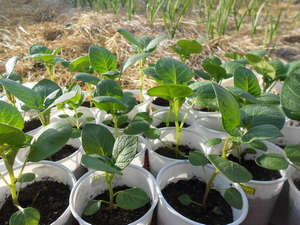 Another solution to the problem is to independently grow potatoes from seeds, since the seeds of degeneration do not accumulate in the seeds, and diseases and viruses are not transmitted with them. They can be collected from the best bushes in your garden, and you can buy in specialized stores. The seeds of potatoes bought in the store will allow growing quality planting material for a low price, and at the same time select best plants and the tubers most adapted to the climate and conditions of your region. On how to grow potatoes from seed, will further discussion.
Another solution to the problem is to independently grow potatoes from seeds, since the seeds of degeneration do not accumulate in the seeds, and diseases and viruses are not transmitted with them. They can be collected from the best bushes in your garden, and you can buy in specialized stores. The seeds of potatoes bought in the store will allow growing quality planting material for a low price, and at the same time select best plants and the tubers most adapted to the climate and conditions of your region. On how to grow potatoes from seed, will further discussion.
Features agrotehnika
A characteristic feature of potatoes grown from seeds is that the plants obtained are not representatives of a pure genetically homogeneous variety. On seed bags it is necessary to indicate that when grown from seeds, you will receive a population of a variety with a diverse set of genes, in which it is possible to select plants with a suitable set of properties.
Cultivation of potatoes by seeds allows you to conduct your own selection and select potato bushes of the highest yield, resistant to diseases and pests.
Ways to grow potatoes from seed
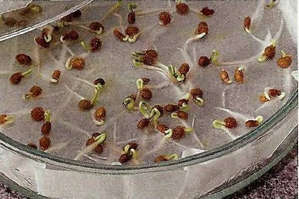 There are two ways to grow potatoes from seed - seedling and seedless. By sowing seeds directly into the soil, only small tubers are obtained, which can be used for propagation, i.e. for landing next season. This method seems simpler, but due to the low germination of seeds, the demands on weather conditions, it is not suitable for open groundrather suitable for greenhouses. At the same time, seedlings can be grown from seed even on the window.
There are two ways to grow potatoes from seed - seedling and seedless. By sowing seeds directly into the soil, only small tubers are obtained, which can be used for propagation, i.e. for landing next season. This method seems simpler, but due to the low germination of seeds, the demands on weather conditions, it is not suitable for open groundrather suitable for greenhouses. At the same time, seedlings can be grown from seed even on the window.
Growing potatoes with seeds is similar in their agrotechnics to the cultivation of tomatoes (both of them are members of the nightshade family), although there are significant differences:
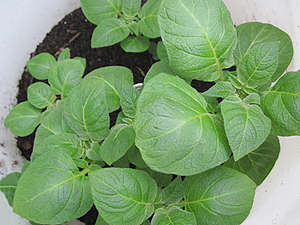
Seed preparation and planting
Growing seedlings begin with the germination of seeds. It is necessary to begin their preparation approximately in the end of March or the beginning of April. Selected seeds should be soaked in water for several days. You should not fill them with water completely, but simply place the seeds in a humid environment, preventing it from drying out - in some container on a rag or on paper, and place it in a warm place, for example, near the battery.
It is possible to increase the germination of seeds by treating them with a solution of some stimulant, for example, Epin. It is useful to subject the seeds to hardening, placing the containers with the seeds at night in the refrigerator, and placing them in the room during the day.
Transplanting and growing seedlings of potatoes
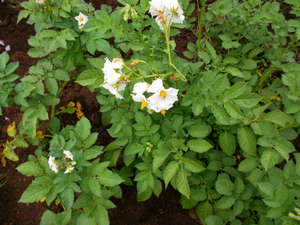 When the seeds sprout, they can be planted in pre-prepared boxes of at least 10 cm deep. They need to be filled with fertile soil mixture (on one part of the earth, four parts of peat with fertilizers), which can be made by oneself, or purchased ready-made in a store. The inclined seeds with a seedling of 5-7 mm are carefully transferred in rows to the surface of moist soil according to the 5 cm scheme between the seeds in a row and 10 cm between the rows. They should be lightly sprinkled with the same soil or prepared (calcined) sand, then compacted with water from the sprayer. Yes, and then watering is better to carry out from a spray, so as not to wash off the seeds that have not yet been rooted with water. The soil surface should be wet all the time, it should not be allowed to dry out and should not be overly poured, since the seedlings of potatoes are located to rot.
When the seeds sprout, they can be planted in pre-prepared boxes of at least 10 cm deep. They need to be filled with fertile soil mixture (on one part of the earth, four parts of peat with fertilizers), which can be made by oneself, or purchased ready-made in a store. The inclined seeds with a seedling of 5-7 mm are carefully transferred in rows to the surface of moist soil according to the 5 cm scheme between the seeds in a row and 10 cm between the rows. They should be lightly sprinkled with the same soil or prepared (calcined) sand, then compacted with water from the sprayer. Yes, and then watering is better to carry out from a spray, so as not to wash off the seeds that have not yet been rooted with water. The soil surface should be wet all the time, it should not be allowed to dry out and should not be overly poured, since the seedlings of potatoes are located to rot.
Boxes with seeds need to cover with plastic wrap or glass and put in a warm place lit - for example, on the window, at the battery. After 10 days, shoots will appear. When they are in the stage of two true leaves, they can be smashed into peat pots or cups, always with a drainage hole. This will facilitate planting grown plants in the ground, but if the seeds were planted infrequently, then you can not do this. It is advisable to turn the boxes so that the seedlings do not stretch in one direction and loosen the aisles.
To improve rooting, you need to feed the plants with a solution of urea (one gram per liter of water) and then shed them with clean water. In the process of growing seedlings, it should be fertilized with complex fertilizer once a month.
The film is removed when the plants rise and become stronger. Seedlings can be hardened by carrying them out onto a glassed-in balcony, and before disembarking, it is generally desirable to leave boxes with seedlings on the balcony for at least a week. The whole process of growing potato seedlings from seeds can be clearly seen in the video.
Planting in open ground
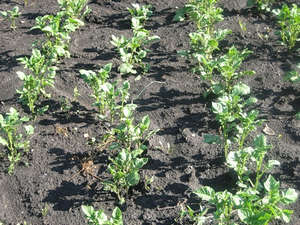 When the threat of frost has passed, somewhere in the twentieth of May, you can think of planting seedlings on the prepared beds.
When the threat of frost has passed, somewhere in the twentieth of May, you can think of planting seedlings on the prepared beds.
The soil must be carefully dug and fertilized - you can apply fertilizer when planting - for example, 300 grams of humus per well. In prepared beds, make the holes ten centimeters deep, water them, and cover the seedlings in such a way that the top three leaves remain on the surface.
The bed with planted seedlings must be protected for the first time from temperature fluctuations by making a small greenhouse. You can cover the film or, even better, spandbond stretched over a frame of arcs. This non-woven material allows the plants to "breathe", does not trap moisture and well protects against accidental night cold and overheating. It is possible to remove the shelter when the seedlings take root and grow, and good weather is finally established. Watering the beds should be the first time once every couple of days, do not forget to loosen the soil and weed in time.
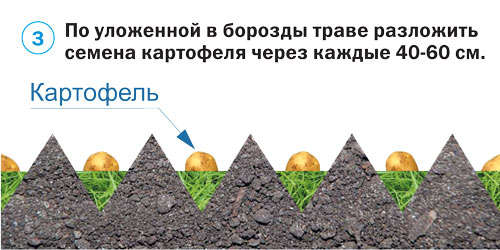 Growing potatoes from seed and from tubers is similar. A month after planting, the sturdy plants have the appearance of lush multi-stem bushes - caring for them will not be any different from the way you take care of potatoes planted with tubers.
Growing potatoes from seed and from tubers is similar. A month after planting, the sturdy plants have the appearance of lush multi-stem bushes - caring for them will not be any different from the way you take care of potatoes planted with tubers.
The beds should be loosened, fertilized, twice a season to tuft the bushes, to protect against the invasion of the Colorado potato beetle and diseases. Excellent results are achieved with complex spraying of potatoes with a combination of insecticides, fertilizers for foliar feeding and preparations for the prevention of diseases, such as phytophthora. All stages of potato growing are reflected in the video.
What do you get as a result
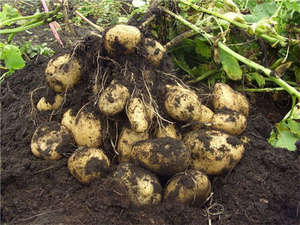 Nothing has been said about the planting pattern of potatoes, and this is one of the decisive factors for obtaining a high yield. If you plant seedlings at a distance of 15-20 cm from each other, then you can get at least a large number of tubers, but they will be small, weighing up to 50 g, suitable for planting next year. If planted at a distance of about 40 cm, then you can get larger (up to 100 g) tubers, although perhaps their number will be smaller. With proper farming practices and favorable conditions, the crop can reach 1 kg per bush.
Nothing has been said about the planting pattern of potatoes, and this is one of the decisive factors for obtaining a high yield. If you plant seedlings at a distance of 15-20 cm from each other, then you can get at least a large number of tubers, but they will be small, weighing up to 50 g, suitable for planting next year. If planted at a distance of about 40 cm, then you can get larger (up to 100 g) tubers, although perhaps their number will be smaller. With proper farming practices and favorable conditions, the crop can reach 1 kg per bush.
Small tubers grown from seed in the first year, in the second season, will produce super elite potatoes, the third year harvest obtained from them is also considered super elite, in the fourth year, potatoes grown will be elite, the fifth year harvest will be ordinary, and from the sixth year must be resumed planting material.
We hope that you are convinced that the answer to the question of how to grow potatoes from seed is not at all difficult, interesting and allows you to save money on the family budget.






